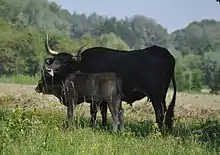Sayaguesa
The Sayaguesa is an endangered Spanish breed of domestic cattle. It is named for the comarca of Sayago in the province of Zamora, in the western part of the autonomous community of Castilla y León, and is raised almost exclusively in that area.[4][5] It may also be known as the Zamorana, the Moles de Sayago or the Castellana variedad Sayaguesa.[2] It was traditionally kept mainly for draught work,[3]: 148 but is now raised principally for meat.[6]
 | |
| Conservation status | FAO (2007): endangered-maintained[1]: 106 |
|---|---|
| Other names |
|
| Country of origin | Spain |
| Distribution | Comarca of Sayago, Castilla y León |
| Standard | Consejería de Agricultura y Ganadería, Castilla y León |
| Use | formerly draught; now meat |
| Traits | |
| Weight | |
| Height | |
| Coat | black, some bleaching |
| Horn status | horned in both sexes |
| |
History
The Sayaguesa was traditionally kept mainly for draught work; with the mechanisation of agriculture following the Second World War, this use declined.[7] In the 1960s there were successive attempts to improve productive qualities by cross-breeding with Friesian, Braunvieh and Charolais, and later with other breeds. From 1970 the Sayaguesa was included with other regional breeds under the denomination Morenas del Noroeste. In 1997 it achieved separate recognition among the breeds identified by the Ministerio de Agricultura, Alimentación y Medio Ambiente, the Spanish ministry of agriculture, as "at risk of extinction".[3]: 147 Registration of the Sayaguesa began in 1980,[3]: 147 and in 1981 a breeders' association, the Asociación Española de Criadores de Ganado Bovino de Raza Sayaguesa, was formed.[8] In 1998 a genealogical herd-book was established.[3]: 147
Between 1950 and 1981 the population of the Sayaguesa fell by about a quarter, or some 17000 head. By 2009 only about 450 head remained, on 29 farms.[3]: 147 At the end of 2015 the population was 1612, of which almost all were in Castilla y León.[5]
Characteristics
The Sayaguesa is one of the largest indigenous Spanish cattle breeds. It displays considerable sexual dimorphism: bulls may weigh up to 1100 kg and cows up to 700 kg.[3]: 148 The height at the withers averages 158 cm for bulls and 154 cm for cows.[9]
The coat is black, sometimes lighter on the underparts. There may be a paler dorsal stripe, often absent in cows. The inside of the ears and the area round the mouth are pale. The hooves, muzzle and natural openings are black, the horns are white at the base and tipped with black.[3]: 148 The head is relatively small, with a concave profile. Calves are born red, and only later turn black.[3]: 148
The Sayaguesa is hardy, robust and frugal, and well adapted to the poor pastures and harsh environment of its native area.[3]: 146
Use
The Sayaguesa was traditionally kept mainly for draught work; with the mechanisation of agriculture following the Second World War, this use declined,[7] and breeding was directed towards meat production.[3]: 147 Calves are slaughtered at an average age of 12 months; yield is approximately 55%.[10]
Pairs of cows may sometimes be yoked to carts for folklore or festival occasions.[11]
The Sayaguesa has been used in nature conservation and in attempts to re-create the extinct aurochs.[12]: 196
References
- Barbara Rischkowsky, D. Pilling (eds.) (2007). List of breeds documented in the Global Databank for Animal Genetic Resources, annex to The State of the World's Animal Genetic Resources for Food and Agriculture. Rome: Food and Agriculture Organization of the United Nations. ISBN 9789251057629. Accessed November 2016.
- Breed data sheet: Sayaguesa/Spain. Domestic Animal Diversity Information System of the Food and Agriculture Organization of the United Nations. Accessed November 2016.
- Miguel Fernández Rodríguez, Mariano Gómez Fernández, Juan Vicente Delgado Bermejo, Silvia Adán Belmonte, Miguel Jiménez Cabras (eds.) (2009). Guía de campo de las razas autóctonas españolas (in Spanish). Madrid: Ministerio de Medio Ambiente y Medio Rural y Marino. ISBN 9788449109461.
- Raza bovina Sayaguesa: Datos Generales (in Spanish). Ministerio de Agricultura, Alimentación y Medio Ambiente. Accessed November 2016.
- Raza bovina Sayaguesa: Datos Censales (in Spanish). Ministerio de Agricultura, Alimentación y Medio Ambiente. Accessed November 2016.
- Raza bovina Sayaguesa: Usos y sistema de explotación (in Spanish). Ministerio de Agricultura, Alimentación y Medio Ambiente. Accessed November 2016.
- [s.n.] (23 November 1998). ORDEN de 30 de octubre de 1998, de la Consejería de Agricultura y Ganadería, por la que se crea el Libro de Registro Genealógico de la Raza Bovina Sayaguesa y se aprueba su funcionamiento (in Spanish). Boletín Oficial de Castilla y Léon 225.
- Origen e Historia (in Spanish). Asociación Española de Criadores de Ganado Bovino de Raza Sayaguesa. Accessed November 2016.
- Raza bovina Sayaguesa: Datos Morfológicos (in Spanish). Ministerio de Agricultura, Alimentación y Medio Ambiente. Accessed November 2016.
- Raza bovina Sayaguesa: Datos productivos (in Spanish). Ministerio de Agricultura, Alimentación y Medio Ambiente. Accessed November 2016.
- Raza Sayaguesa (in Spanish). Federación Española de Asociaciones de Ganado Selecto. Archived 15 July 2006.
- Valerie Porter, Lawrence Alderson, Stephen J.G. Hall, D. Phillip Sponenberg (2016). Mason's World Encyclopedia of Livestock Breeds and Breeding (sixth edition). Wallingford: CABI. ISBN 9781780647944.